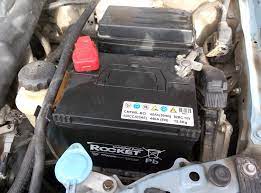
What is the forward and reverse polarity of the battery?
Content
Each storage battery has pole terminals on the body - minus (-) and plus (+). Through the terminals, it connects to the vehicle's on-board network, supplies the starter and other consumers. The location of the plus and minus determines the polarity of the battery. It is important for drivers to know exactly the polarity of the battery in order not to mix up the contacts during installation.
Battery polarity
Polarity refers to the arrangement of current-carrying elements on the top cover or front side of the battery. In other words, this is the plus and minus position. The current leads are also made of lead, like the plates inside.
There are two common layouts:
- straight polarity;
- reverse polarity.
Straight
During the Soviet period, all domestically produced batteries were of direct polarity. Pole terminals are located according to the scheme - plus (+) on the left and minus (-) on the right. Batteries with the same circuit are produced now in Russia and in the post-Soviet space. Foreign-made batteries, which are made in Russia, also have this pinout scheme.
Feedback
On such batteries, there is a minus on the left, and a plus on the right. This arrangement is typical for European-made batteries and therefore this polarity is often called "europolarity".
The different scheme of the situation does not give any special advantages. It does not affect design and performance. Problems may arise when installing a new battery. The opposite polarity will cause the battery to change position and the wire length may not be enough. Also, the driver may simply confuse the contacts, which will lead to a short circuit. Therefore, it is important to decide on the type of battery for your car already when buying.
How to determine?
It's not that hard to find out. First you need to turn the battery to face you. It is located on the side where the characteristics and logo stickers are located. Also, the pole terminals are closer to the front side.
On many batteries, you can immediately see the "+" and "-" signs, which accurately indicate the polarity of the contacts. Other manufacturers indicate information in the markings or highlight the current leads in color. Usually the plus is red and the minus is blue or black.
In the marking, reverse polarity is indicated by the letter "R" or "0", and the forward letter - "L" or "1".
Differences in the case
All batteries can be roughly divided into:
- domestic;
- European;
- Asian.
They have their own manufacturing and pinout standards. European batteries, as a rule, are more ergonomic and compact. Outlet contacts have a larger diameter. Plus - 19,5 mm, minus - 17,9 mm. The diameter of the contacts on Asian batteries is much smaller. Plus - 12,7 mm, minus - 11,1 mm. This also needs to be taken into account. The difference in diameter also indicates the type of polarity.
Can I install the battery with a different polarity?
This question often arises from those who inadvertently bought a battery of a different type. In theory, this is possible, but it will require costs and unnecessary red tape with the installation. The fact is that if you buy a battery with reverse polarity for a domestic car, then the length of the wires may not be enough. You won't be able to lengthen the wire just like that. The cross-section and diameter of the terminals must be taken into account. It can also affect the quality of the current transfer from the battery.
The best option would be to replace the battery with another with a suitable contact arrangement. You can try to sell the purchased battery, so as not to be at a loss.
Reversing battery polarity
Some drivers resort to the battery polarity reversal method. This is the procedure for swapping plus and minus. It is also done to restore the health of the battery. Reversing the polarity is recommended only in extreme cases.
Attention! We do not recommend carrying out this procedure on your own (without the help of professionals) and in conditions that are not specially equipped. The sequence of actions below is provided as an example, not instructions, and for the sake of completeness of disclosing the topic of the article.
Reverse polarity sequence:
- Discharge the battery to zero by connecting some kind of load.
- Connect the positive wire to the minus, and the negative to the plus.
- Start charging the battery.
- Stop charging when the cans are boiling.
In the process, the temperature will begin to rise. This is normal and indicates a polarity reversal.
This procedure can only be carried out on a serviceable battery that can withstand active sulfation. In cheap batteries, the lead plates are very thin, so they can simply collapse and not recover. Also, before starting to change the poles, you need to check the density of the electrolyte and cans for a short circuit.
What can happen if mixed up during installation?
If the polarity is reversed, the following can happen:
- blown fuses, relays and wires;
- failure of the diode bridge of the generator;
- burnout of the electronic engine control unit, alarm.
The simplest and cheapest problem can be blown fuses. However, this is their main function. You can find a blown fuse with a multimeter by "ringing".
If you confuse the contacts, then the generator, on the contrary, consumes energy from the battery, and does not give it. The generator winding is not rated for the incoming voltage. The battery can also be damaged and damaged. The simplest option would be to blow out the desired fuse or relay.
Failure of the electronic engine control unit (ECU) can be a big problem. This device requires polarity to be observed despite the built-in protection. If the fuse or relay does not have time to blow, then the ECU is likely to fail. This means that the car owner is guaranteed expensive diagnostics and repairs.
Most devices in the car's electrical system, such as a car radio or an amplifier, are protected against polarity reversal. Their microcircuits contain special protective elements.
When "lighting" from another battery, it is also important to observe the polarity and the sequence of the connection of the terminals. Incorrect connection will cause a 24 volt short. If the wires have a sufficient cross-section, then they can melt or the driver himself will be burned.
When buying a new battery, carefully read the labeling and ask the seller for all the characteristics of the battery. If it so happened that you purchased a battery with the wrong polarity, then it is best to replace it or buy a new one. Extend wires and change the position of the battery only as a last resort. It is better to use a suitable device than to spend money on expensive repairs later.
